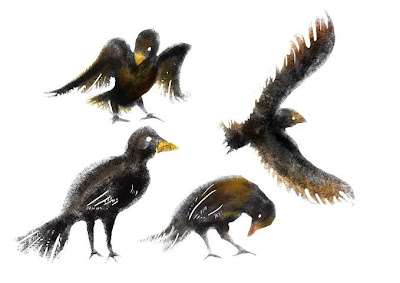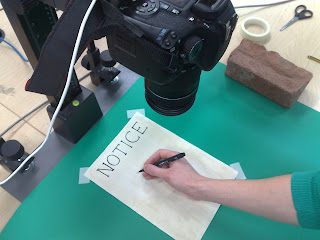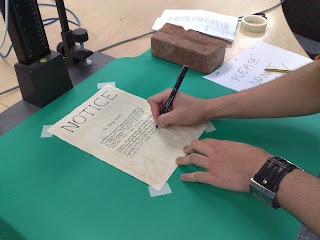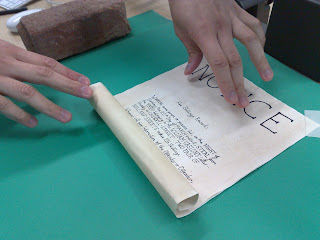In this report, I will be writing about the collaborative work with the third years mainly working on my specialism of 2D animation traditionally and digitally. I will be explaining the method on how I helped them and developed some of their work with supporting images in this report. Later at the end of the report, I will be writing about my conclusion and my employability for my animation course.
I have always been
fascinated by all different kinds of animation, 2D, 3D and stopmotion. My dream
is to specialize in all areas but for now, I will focus mastering them one at a
time. I love the idea of combining all styles into one because it gives off a
very unique feel to the animation. I love exploring different Medias and
finding better ways to animate.
For now I will be
focusing on 2D traditional and digital animation. This animation style inspired
me as a child to one day animate like the professionals. I was very fascinated
with the animation, creativity of the character designs, exaggeration and story
lines. A good example is one of my favourite animes (Japanese Animation) called
One Piece by Eiichiro Oda. During the 1997, One Piece was animated
traditionally (cell animation) but then developed on through the years and
animated digitally to save time and money.
My goal in the future
is to bring back traditional animation with some help of 2D digital animation.
The traditional animation gives more character and natural feel to the
animation. I will be combining this with digital animation to animate most of
the background and effects by using After Effects, flash or toon boom or any
other new softwares coming out, which I will be learning soon.
At the start of the
Pre-Production of specialist study, I have collaborated with quite a few third
year students doing different kinds of tasks each which all relates to my
specialism 2D animation. Some of my work for them is still on-going and will be
complete after the deadline of this project.
My first
collaboration was with a third year student Roxy Gomez. We have met quite a few
times face to face discussing about her project which is about a Native
American story which involves mostly about the animals. It is targeted to a
younger audience from ages nine to thirteen. We have discussed about methods on
how to complete her animation, she wanted a mixture of traditional and digital
animation using many different softwares altogether. But her main style is to
show a natural hand drawn characters that relates to the Native American theme.
She has asked me to help her design some characters for her final year
animation. She was very impressed by my drawing and photoshop skills, she
wanted me to design her some Native American characters which will be based
from her own research on her blog. After my designs are made, she will decide
whether to use the same style I made or not. This will still be added on to her
character development and art styles.

This is a crow design
I have created for Roxy using Photoshop. I have based my design from her
research cave paintings. I have used photoshop charcoal brush tool to create a
grungy smudge effect and have used two minimal colours. I made a negative
drawing by using the eraser tool to rub off the edges to create a nice clean
outline. I made them look very spiritual with less detail and simple shapes,
with soft edges almost look like they’ve been smudged. Alternative way is to
create a white mask of the bird shape then colouring it afterwards.



These are some art
work style I have designed for Roxy which has been taken from her story board.
I made this to give her more variety of development work and she can later
decide which style to follow. Doing this work for Roxy improves my knowledge
and skills in photoshop, it also gave me more idea about Native American art,
especially the character designs which are very simple based on basic shapes.


After working with
Roxy, I have been contacted by Ashton Lewsey for wanting help as soon as
possible to rotor scope her work. I didn’t have enough time to know what her
project is about, all I know is that she needs this work done quickly, and her
target audience are young adults. The task that has been given to me is a very
easy job because I am used in handling photoshop. All I had to do is just delete
the sky and the streets and replace textures at the back of every frame. The
hard part of this task is to complete all frames in a few hours. The first
thirty minutes was hard because I have only just started and not yet used to
tracing around the images, but then I began working fast on two frames in every
five minutes. I have met the deadline and I am proud of myself for working hard
and fast with good quality. I feel I have achieved quite a lot from this task.
I got to experience my first time rotor scoping and working on a tight
deadline. This has also given me more idea about using mixed media in the
future for my 2D animation.
After working with
Roxy and Ashton, more third years wanted some more help. Roshni Kakad asked me
to make a series of different smoke intro using after effects. At first, I
didn’t know how to animate the smoke and make it look realistic. I looked
online for video tutorials and found a really good tutorial on Video
Copilot.com. This kind of animation style is still too new for me. Using stock
video footage in after effects and using it on Trapcode’s particular to create
my own smoke effect. In that tutorial, I have also learnt how to use colour
corrections which makes the footage bring out the best of its qualities and change
the colours and effects. After finishing the first test sample, Roshni wanted
more smoke effect on the text as it disintegrates and animate the text flying
around. So far I have created three tests and the work is still on-going till
the twenty fourth of May. I have enjoyed myself working on after effects
because, there are so many interesting things I can do with it. I can make
effects, animate, edit videos etc…
Working with the
third years was enjoyable, because I love collaborating with other people.
Group meeting is always important for easier discussion of the work and more
can be done. Although I haven’t met Ashton in person to discuss about her work,
we communicated through emails, facebook and calling each other. I have completed
all work needed on the right deadline except for Roshni’s because it is still
an on-going work. I have followed the learning methodology of kolb’s theory by
planning and experimenting different ways to achieve my goal, then trying it
out first hand by experiencing it. I have then reflected on my process and
learn from my experiences. This resulted in a series of solutions to various
issues that have helped me to improve my animation practices.
I love learning
different process of animating, using mixed media and digitally. This also gave
me an idea for the future final animation in my third year. I will be combining
all techniques I have learnt during my three years in university. At the
moment, I am concentrating learning more about Affer Effects, Flash and Toon
Boom. After mastering these programs, I will then move on and learn more new
programs such as Nuke, Smoke, 3DS Max.
After graduating from
University, my plan is to get my name out to the industries and gain knowledge
and experience from them. I probably won’t get paid straight away because I
have less experience from them. After working and learning more from the
professionals, I will incorporate all I have learnt and create more of my own
animation, build up my show reel and apply to other better companies. A good
way to apply for a job is to apply in more than one company. One should hire
me, if not I should try every month.
This is my video presentation for my Pre- Production of specialist study
This is my video presentation for my Pre- Production of specialist study
This is the Final Animation Me and Michael Price made for the Caslon Project
3D test
Unedited green screen stopmotion
1st text stopmotion animation



We wanted to combine 2d, 3d and stop motion, we would like to add in a live footage of a person dressed as a victorian person for the intro using the milo. but thats only if we got time.
this is the finalised the story board in photoshop i drew explaining step by step how to animate in 2d, 3d and stopmotion
me and michael have worked together before and we trust each other to do our best. we will be dividing our work half and half to save time
while i finalised my storyboard and animate the 2d intro as a substitute of the live footage, michael went ahead and animated the 3d animation of the gavel
then later on we worked together on making a stopmotion text writing test frame by frame which gives off a more natural feel
after the test, we started shooting our stopmotion on a greenscreen, we will then key it off aftereffects after the animation. it took hours to shoot but finally succeeded very well
we learnt quickly how to key the green screen off from youtube tutorial, it is very easy. then we edited all our animations together combining the 2d, 3d and stopmotion. we are very pleased with the results.
in my conclusion, I have found communicating with the group is very important and easy to get the message across. I have learnt new techniques, rotorscoping, green screen keying and editing live footage on after effects.
time management is very important to balance all project work. I found some difficulties with universitys facilities equipment but over comed it in the end






.jpg)
.jpg)
.jpg)

















